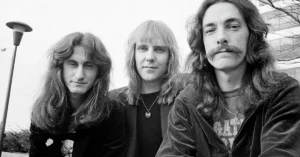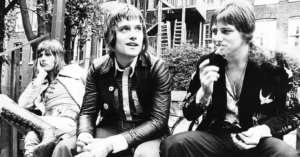Barclay James Harvest: Symphonic Rock’s Unsung Storytellers
Barclay James Harvest. I. Formation and Origins
Formed: 1966
Origin: Oldham, Lancashire, England
Barclay James Harvest. Classic Lineup:
- John Lees – Vocals, guitar
- Woolly Wolstenholme – Keyboards, mellotron, vocals
- Les Holroyd – Bass, vocals
- Mel Pritchard – Drums
Initially inspired by The Beatles, The Moody Blues, and classical music, the band started as The Blues Keepers before adopting the more distinctive name Barclay James Harvest — a fictional composite evoking English pastoral imagery and artistic ambition.
In their early days, the band was known for experimenting with orchestral textures, working with the Barclay James Harvest Orchestra to integrate symphonic music directly into rock compositions.
Barclay James Harvest. II. Early Albums and Orchestral Ambition (1970–1974)
Signed to EMI’s progressive label Harvest Records, they released a string of critically praised, commercially modest albums that laid the groundwork for their future success.
✦ Barclay James Harvest (1970)
- Featured “Taking Some Time On” and “Dark Now My Sky”
- Noted for its melancholic tone and full orchestration
✦ Once Again (1971)
- Widely regarded as one of their finest albums
- Included the classic “Mocking Bird”, a mellotron-driven anthem of romantic regret
- Also featured “Galadriel,” praised by John Lennon himself
- Established their signature: melodic, emotional rock with literary depth
✦ And Other Short Stories (1971) and Baby James Harvest (1972)
- Continued their lush, baroque sound
- Highlights include “The Poet,” “Ursula,” and “Moonwater”
Though not huge sellers in the UK, these albums gained a devoted following in continental Europe, especially in Germany, where their style resonated deeply.
III. Polydor Years and Growing Popularity (1974–1980)
Switching labels to Polydor brought a more streamlined sound and larger audiences.
✦ Everyone Is Everybody Else (1974)
- Marked a creative and commercial turning point
- “Child of the Universe” became a radio staple
- The album combined progressive ideals with accessible melodies
- Voted one of the best albums of the year by John Peel’s listeners
✦ Time Honoured Ghosts (1975)
- Recorded in the U.S.; more polished production
- Included “Jonathan” and “Titles” (a tribute to The Beatles)
✦ Octoberon (1976) and Gone to Earth (1977)
- “Hymn” (from Gone to Earth) became one of their most beloved songs — a plea against drug abuse disguised as a religious hymn
- Gone to Earth sold over 1 million copies in Germany alone
Barclay James Harvest earned a reputation as the “poor man’s Moody Blues,” but this label ignored their deeper emotional content, political lyrics, and uniquely British melancholy.
IV. Stadium Rock and Symphonic Grandeur (1980–1987)
In the 1980s, BJH leaned further into melodic rock while maintaining their symphonic roots.
✦ Eyes of the Universe (1979) and Turn of the Tide (1981)
- Featured the hits “Love on the Line” and “Life is for Living”
- Hugely successful in Europe, especially in Germany and Switzerland
✦ Berlin – A Concert for the People (1982)
- A landmark moment: the band played a free concert to over 250,000 people in front of the Reichstag in West Berlin
- The event cemented their legendary status in Germany
- The live album was a major success
✦ Later ’80s albums:
- Ring of Changes (1983), Victims of Circumstance (1984), and Face to Face (1987)
- Saw further commercial success, but divided fans over their shift toward synth-driven pop-rock
Despite some criticism, the band remained a touring powerhouse, drawing large crowds and remaining active across Europe.
V. Splits and Parallel Careers (1990s–Present)
Internal tensions led to a split in 1998, resulting in two versions of the band:
✦ Barclay James Harvest Featuring Les Holroyd
- Continued touring and recording under this name
- Released Revolution Days (2002) and North (2013)
Barclay James Harvest. ✦ John Lees’ Barclay James Harvest
- Focused more on the progressive and orchestral roots
- Released Nexus (1999), North (2013), and Live in Concert at Metropolis Studios
- Attracted fans of the band’s early sound
✦ Tragedy:
- Woolly Wolstenholme tragically took his own life in 2010, after years of depression
- He was a key creative force and is still deeply missed by fans
Barclay James Harvest. VI. Musical Style and Themes
Barclay James Harvest blended:
- Melodic progressive rock and classical influences
- Lush orchestrations, mellotron textures, and lyrical storytelling
- Soaring harmonies and introspective lyrics
Lyrical themes included:
- Alienation, war, and environmental concerns
- Spiritual searching and lost love
- Political reflections, such as in “Child of the Universe” and “Hymn for the Children”
Their music often felt like a bridge between the symphonic grandeur of Genesis and the romanticism of The Moody Blues.
VII. Legacy and Influence
Though rarely mentioned in mainstream progressive rock histories, BJH holds a deep and lasting influence, particularly in Europe.
Their legacy includes:
- Pioneering the fusion of classical music with rock outside the UK mainstream
- Selling millions of albums across the world
- Cultivating a loyal fanbase despite limited UK/US radio play
- Maintaining musical integrity and emotional depth across decades
They are frequently cited by fans as one of the most underrated prog-rock bands.
VIII. Interesting Facts
- The Berlin concert in 1980 is still remembered as one of the largest ever free concerts in German history
- “Hymn” is often misinterpreted as religious but is actually a critique of drug culture
- BJH was one of the earliest bands to tour with a full orchestra, despite the massive cost
- The song “Mocking Bird” originated from a lullaby John Lees wrote in 1968
- Their logo — a stylized butterfly — is one of the most iconic in classic rock merchandising





